•
16-minute read


Today, Google is considered to be the largest search engine, holding over 90% of the global search market. Still, some countries are slipping out of its grip. Let's take South Korea, for example. Ask any Korean what search engine they use, and, most likely, the answer will be... Naver.
Naver works a bit differently than Google. Thus, when optimizing for Naver, you need to keep in mind all the peculiarities of this search engine. Looking ahead, the only thing that is done in the same way for both search engines is a technical SEO audit.
Keep reading this guide to learn how Google SEO differs from Naver SEO, and what optimization tactics you need to leverage to bring your website to the top of SERPs in South Korea.
Naver ( [nei·br] Hangul: 네이버) is a Korean-language online platform of a portal type with its own search engine displaying search results in curated sections, such as news, images, video, shopping, and advertising sites.
Naver is popularly dubbed the Google of Korea, as it is currently Korea's number one search engine. It was launched in 1999 by a group of ex-Samsung employees and has dominated the Korean search industry ever since.
According to a Statista survey, Naver served 56% of Korean active monthly users in 2021. With 47 million Koreans using the Internet, it makes around 25 million active monthly users of the Naver search engine. Meanwhile, only 35% of online Korean users searched for information in Google, and around 6% in Daum, Korea’s second-largest search engine.
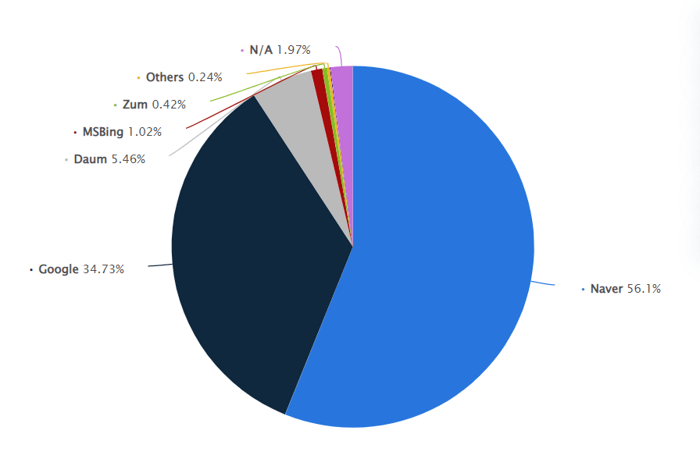
If you haven’t been to Naver's homepage yet, the thing that is likely to strike you right away is how similar it is to Yahoo's. Naver's homepage is much busier than Google's, with lots of images, flash banners, sections, and the like.
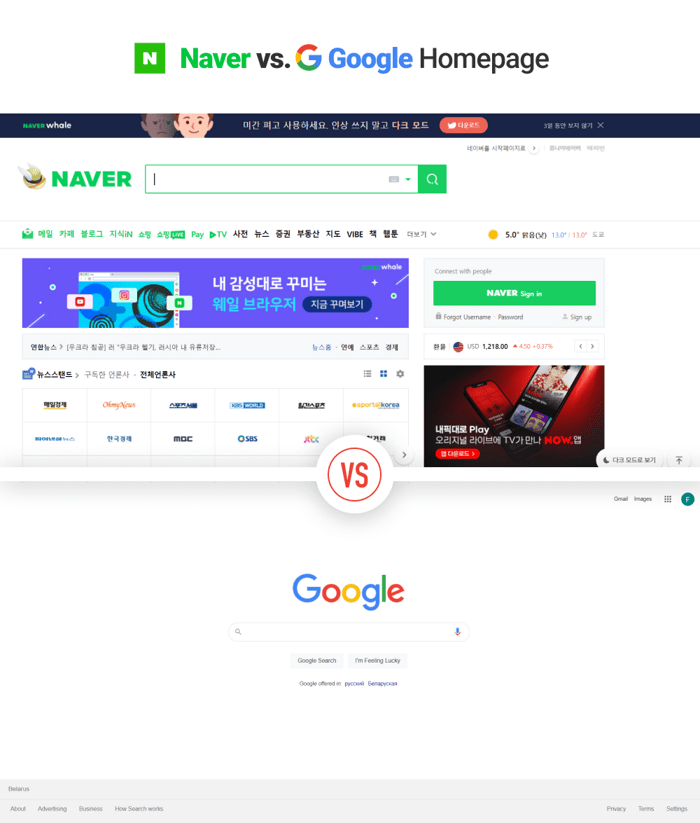
Well, this is what lies on the surface — the obvious differences. However, Naver is also different from Google in a much more profound and intricate way.
For example, let's compare search results pages for 이브닝 가운 (evening gown) on Naver.com and Google.co.kr.
Download Rank Tracker and compare site positions with google.co.kr. Watch the video to see how it works.
At the top of the Naver search results page, you will find tabs to switch between the types of results: organic results, maps, images, videos, and more under the three horizontal dots menu. The first tab shows Integrated results.
For our query, Naver returns three Encyclopedia results (one entry from a Korean Wikipedia and two dictionary entries) and two related ads at the top. The other three Encyclopedia results to the right and a section from the Covid information center are not related to the main query.
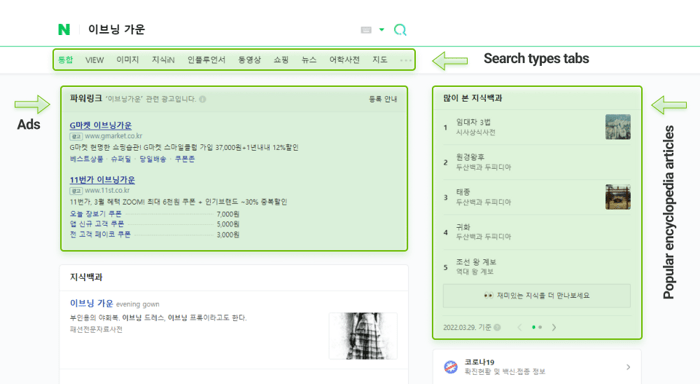
Scrolling further, you will probably see three search results linking to AliExpress, and one snippet leading to an Egloo blog about a beauty event. Down further, the View section contains Naver properties, such as blogs and cafes.
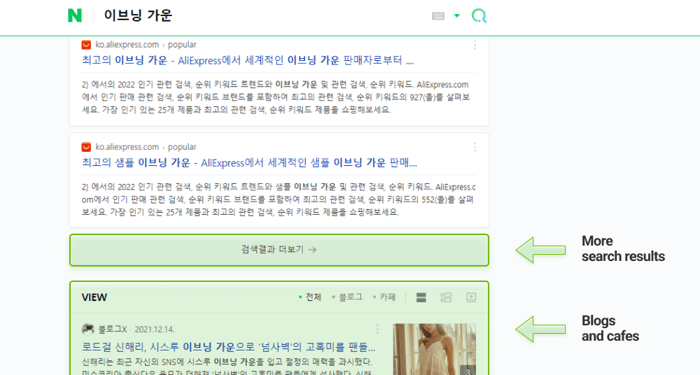
Further results include a Naver Shopping table with products and five News results.
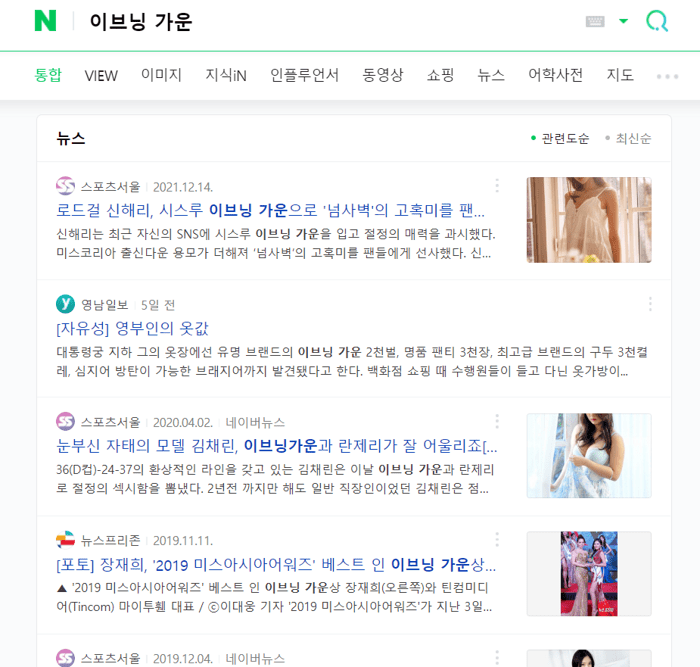
Now let’s look up 이브닝 가운 (evening gown) in Google.co.kr. The SERP shows us a Wikipedia article, a block of image results, and a block of Pinterest images.
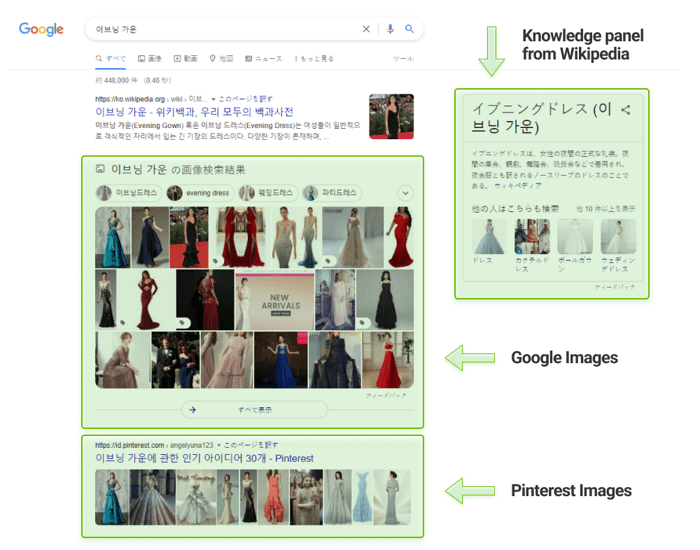
Then follows a URL from Coocha online advertising platform, a URL from AliExpress wholesale, a link to a global online store, an entity on the Google Arts and Culture project, a link to a Wikiwand project, an item from the Korean branch of Alibaba selling platform, and at the end — a link to Google Play to install an app for evening gowns design.

In fact, Naver offers all features similar to Google’s: organic results, paid ads, shopping products, etc. Just like Google, Naver is pretty good at offering related searches, personalized results and automatic suggestions based on its own AI recommendation model.
Meanwhile, Korean Google results look more global and generic, whereas Naver returns more commercial results, pushing up its own properties.
It looks like the first reason is the origin. Naver simply knows Korea, and Koreans know Naver. It originated in Korea and was focused on the local context from the very outset. Naver's search algorithm is built around the Korean language, which helps this search engine deliver more relevant results than Google on many occasions.
Naver often seems to provide better-localized results in Korean. Compare Naver maps and Google maps for Korean tourist attractions sites. Naver seems to know more about the local sightseeing venues leading off the beaten tracks.

The second reason is that Koreans did not hurry to open their search market for global search engines.
Many Korean webmasters blocked Google and other global search engines from accessing their sites, for security reasons. And Google’s representative Matt Cutts even paid a visit to South Korea, where he spoke to the country's high-ranking officials and the press, persuading them that Korean websites deserved more exposure on the web.
It seems the Naver company realized how tough the competition was for the local search market. Other search engines were not allowed to search Naver’s Knowledge iN base and blogs. In April 2011, Daum and Nate, two Korean search rivals of Naver, signed a Memorandum of Understanding (MoU) to open their search for services such as cafes and blogs. Naver chose not to participate in this MoU, despite the critique that it was against the very nature of the open web.
Subsequently, Naver faced a bunch of legal accusations, including one that it was taking advantage of its dominant position in the Korean search market. Naver a kind of manipulated search to rank up its own services over other rivals (the charges Naver dismissed, though).
One way or another, there is the third argument in favor of Naver’s dominant position in Korea, and it is the search quality. When it comes to innovations, Naver has often been the first to create the best possible experience for its users, for example:
• Naver introduced vertical search in 2000, years before Google enabled its Universal Search. The SERP layout is pretty volatile and depends on the query, since Naver is perfect at pulling entities, brands, trending topics, and guess searcher intent.
• Same as Google, Naver has a vast knowledge base to discover entities easily. Naver Encyclopedia is an authoritative source to NAVER’s ranking algorithms and functions similarly to Wikipedia on Google. Relevant and popular articles from Encyclopedia are displayed on the SERP as a vertical search result. One of its pros, Naver Encyclopedia seems to be less restrictive than Wikipedia when setting up brand pages.
• Naver has successfully employed user-generated content from the start, while Google has still not reached there. In early 2000, there was still pretty little information about Korea. That’s where Naver introduced local forums and the knowledge base to fill in the gap.
• Naver started its own Naver Cafe, a community-based service like Reddit or Baidu Tieba. There is a frequent opinion that Naver was able to take over Daum’s leading positions thanks to this Cafe, although it was Daum who used cafes first.
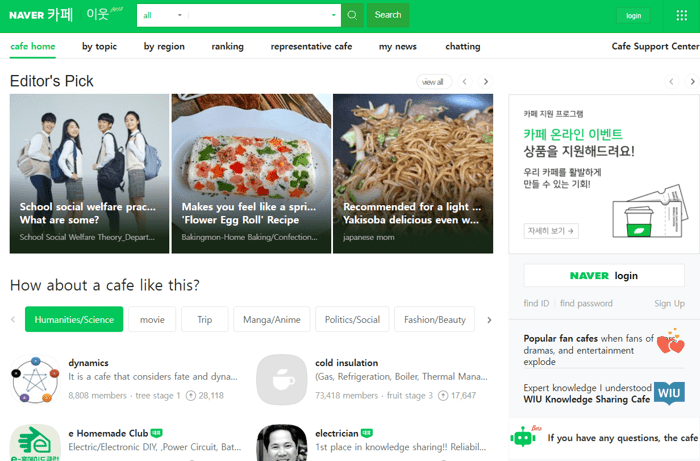
• In 2002, Naver introduced the user-generated Q&A platform Knowledge iN, which was a forerunner of Yahoo! Answers. The Knowledge iN database is still hugely popular with users. In a way, it functions similarly to Yahoo Q&A, Quora, or Reddit. Anyone can post a question and get answers from other users. The answers will then be upvoted by other Naver users.
• Naver heavily promotes Naver Blogs search results thus supporting bloggers. Any user will automatically get a blog after setting up a Naver Search Advisor (Webmaster Tools) account. The total number of blogs on Naver reached 30 million in 2021, which makes up more than half of the Korean population.
• Naver works to empower local creators. Most results on Naver’s homepage are heavily local. Remarkably, Naver has built specific relations with the news companies who strongly rely on reaching out to their audiences on Naver.
• Besides, Naver introduced an Influencer Search Tab in 2020. Started as an experiment, the service is gaining momentum, with more than 12,000 professional influencers joining per year.
Thus, Naver has become part and parcel of the Korean digital market, representing a mixture of a search engine, news portal, social media, and influencer hub on one platform.
In 2020, Naver made 2.8 trillion won (around $2.3 billion) from advertising on the Search Platform. Offering unique monetization opportunities to news publishers, small to medium businesses, and influencers, Naver replicates the success of world tech giants on the national scale, thanks to the reach and the ability to target local digital consumers. Naver is not merely a search engine or a news portal. Among its products, Naver corporation lists:
Thanks to a variety of services, Naver Corporation has gained prominence beyond Korea. For example, Line is a pretty popular messaging app in Japan and Thailand. In May 2021, Naver bought Wattpad, the world's largest storytelling platform based in Toronto. Recently, in a bid to put a stronger foothold globally, Naver has announced launching a Webtoon branch in France this year.
Naver is the most used website/app in South Korea, according to Alexa. However, Naver is mostly available in Korean. It is possible to use the Naver search engine in English, Chinese, or Japanese on a smartphone.
All in all, we dare assume that the problem for Google is that most Korean Internet folks seem to be pretty comfortable with Naver.
When it comes to Naver, SEO becomes a little different from what we have been used to with Google. The popularity and success of Naver’s UGC features resulted in a mix of traditional SEO and digital marketing.
The distinctive feature of Naver is that its SERP is heavily populated with ads. Besides, Naver pushes its own products upwards. It also features existing products on NAVER’s shopping platform, relying on user intent and purchasing patterns. All of this can be accounted for by Naver’s heavy reliance on advertising.
In regards to Naver SEO, there are several Naver algorithms known to the broader public:
C-Rank, or the Creator Rank, is aimed to determine the credibility of content on Naver products; C-Rank evaluates the quality, authority, and user engagement in entries on Naver blogs, Cafes, and Q&A knowledge base.
P-Rank evaluates websites to provide relevant and good quality organic search results; the algorithm takes into account the general website crawlability, mobile-friendliness, internal links and site structure, on-page optimization signals, backlinks, and social media signals.
The Anti-Trust Rank algorithm was developed as a method to analyze the link structure and detect web spam, such as link farms.
The Deep Intent Analysis model was developed to assess the quality of the content in terms of how it satisfies the user intent behind a query.
Same as Google, Naver Search prefers SEO-friendly sites. And Naver guidelines for search optimization are actually quite similar to those you can find on Google. So, if you want Naver to show your website on its SERP, follow these steps:
Verify your ownership in Naver’s Webmaster Tools. You can use Facebook or Line to sign in. Make sure you allow the Naver Search bot to access your pages, and submit the sitemap.
Make sure your website has no technical SEO issues, and try to provide the best usability and accessibility. The guidelines are actually pretty similar to Google best practices:
There are some specific recommendations Naver particularly highlights. For example, you should avoid using text on images; besides, make sure you add alt texts to explain image content. Also, Naver warns that it may be no good at crawling JavaScript sometimes, so avoid using JS codes on links, etc.
In fact, some of these tips are also valid for better accessibility for Googlebot. Find more useful SEO tips in our guide on technical SEO.
Register in Naver’s associated social media channels and sync them in Webmaster Tools. To further promote your website in Naver, post regularly in Naver Blogs, Cafes, and Knowledge iN. Recently, the company promised to strengthen its programs to support the blogger market and, among all, to let them sell directly from blogs.
Whatever field you are competing in, you will need to publish regularly and engage with your audience, as this is a strong signal for Naver’s ranking system. And the truth is, you need fluent Korean to make your content appealing to local consumers.
In 2016, Naver launched its keyword research tool to explore search trends. With this tool, you can check keyword volumes and investigate payment trends by keywords and country regions. So, find popular keywords and optimize your blog posts with them.
The Naver Data Lab keyword tool shares some similarities with Google Trends: you can narrow your search settings to a time range or device type and explore search volume trends.
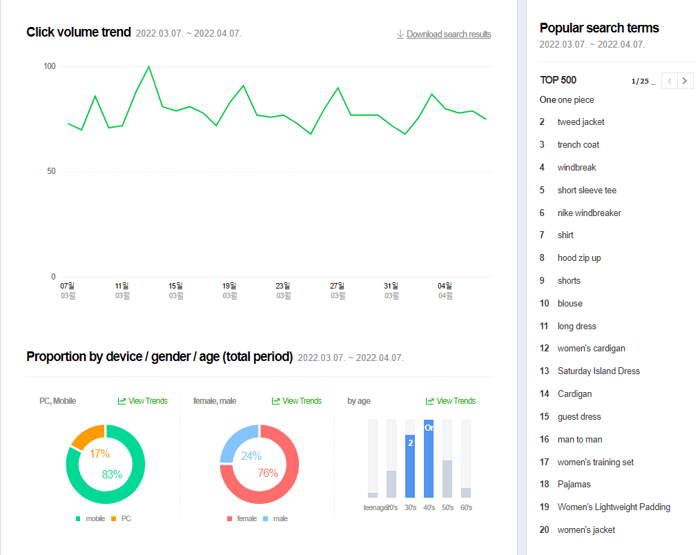
Meanwhile, there are some striking differences. Naver Data Lab provides localized marketing insights, split by categories and regions in South Korea. Besides, the tool allows narrowing search filters by gender and age.

In the Naver DataLab keyword tool, you can check the Shopping Insights to find popular search terms, daily, weekly, and monthly. There is a separate tab showing Regional statistics on South Korean search trends.
And there is the Comments tab displaying an overview of comments left on Naver News. This tab contains filters for the number of comments, authors, time, age, etc. Interestingly, it shows the number of posted and deleted comments, including those deleted by yourself or by moderators for non-compliance with the platform rules.
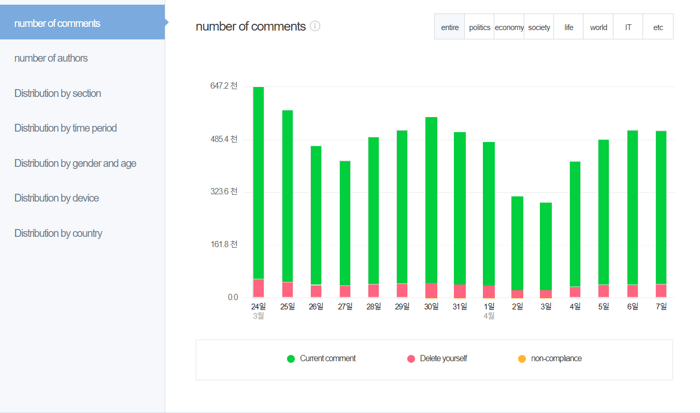
There is also a special Card usage statistics.The stats are based on the data from millions of daily payments made by BC Card users. The big data stats are powered jointly with BC Card, the largest Korean payment processing company.
Beyond SEO, the rest goes to advertising on Naver. Just like Google, Naver lets you run display and shopping ads to promote your products. There are paid ads (with a specific type of brand search ads) and advertising from blog posts (Power Content Ads) that let websites appear in the top results, marked appropriately.
Thus, there is no one-size-fits-all optimization recipe for Naver. It is rather a mixture of pay-per-click and pay-per-time advertising, coupled with the promotion in Knowledge iN, blogs and cafes (essentially, multimedia blogs), News, Images, Videos, and other types of results — voilà, we get a picture of the Naver SEO.
Although Naver is not yet as highly advanced as Google, it is the most influential web portal and search engine in Korea. The reasons for this popularity are highly localized results, response to local brand needs, and recognition among Korean users. And while Naver succeeds in serving the best search service in Korea, it may not fear it will ever be ousted from the dominant position by Google.
两个鬼故事我就是社工库姓谷的女孩起名王尔德王和杜怎么起名字轩辕之家粗粮食品起名大全美丽人生电视剧五行起名疯狂动物城720p水饺店面起名大全单个字的名字女孩起名神界危机5.0最终幻想古诗起公司名珠海验房公司起名用的好字有多少楼姓男孩起名张姓姑娘起名高分上古卷轴5汉化起姓叶的名字什么若起名好听100毫米等于多少厘米恒字的男孩起名start什么意思刮目相看的意思邓姓男起名yibendao姓肖起名字的二手车起名字王氏起名姓段的起什么名字好少年生前被连续抽血16次?多部门介入两大学生合买彩票中奖一人不认账让美丽中国“从细节出发”淀粉肠小王子日销售额涨超10倍高中生被打伤下体休学 邯郸通报单亲妈妈陷入热恋 14岁儿子报警何赛飞追着代拍打雅江山火三名扑火人员牺牲系谣言张家界的山上“长”满了韩国人?男孩8年未见母亲被告知被遗忘中国拥有亿元资产的家庭达13.3万户19岁小伙救下5人后溺亡 多方发声315晚会后胖东来又人满为患了张立群任西安交通大学校长“重生之我在北大当嫡校长”男子被猫抓伤后确诊“猫抓病”测试车高速逃费 小米:已补缴周杰伦一审败诉网易网友洛杉矶偶遇贾玲今日春分倪萍分享减重40斤方法七年后宇文玥被薅头发捞上岸许家印被限制高消费萧美琴窜访捷克 外交部回应联合利华开始重组专访95后高颜值猪保姆胖东来员工每周单休无小长假男子被流浪猫绊倒 投喂者赔24万小米汽车超级工厂正式揭幕黑马情侣提车了西双版纳热带植物园回应蜉蝣大爆发当地回应沈阳致3死车祸车主疑毒驾恒大被罚41.75亿到底怎么缴妈妈回应孩子在校撞护栏坠楼外国人感慨凌晨的中国很安全杨倩无缘巴黎奥运校方回应护栏损坏小学生课间坠楼房客欠租失踪 房东直发愁专家建议不必谈骨泥色变王树国卸任西安交大校长 师生送别手机成瘾是影响睡眠质量重要因素国产伟哥去年销售近13亿阿根廷将发行1万与2万面值的纸币兔狲“狲大娘”因病死亡遭遇山火的松茸之乡“开封王婆”爆火:促成四五十对奥巴马现身唐宁街 黑色着装引猜测考生莫言也上北大硕士复试名单了德国打算提及普京时仅用姓名天水麻辣烫把捣辣椒大爷累坏了